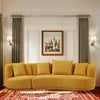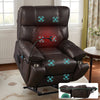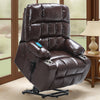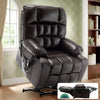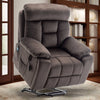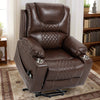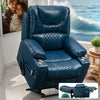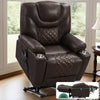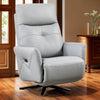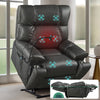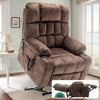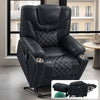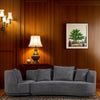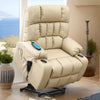The Essence of Mid-Century Modern Style
Characteristics of Mid-Century Furniture
Mid-century furniture, celebrated for its time-honored charm, is defined by several key characteristics. Its design philosophy favors function over excess ornamentation, resulting in clean lines and minimalistic forms that seamlessly blend utility with beauty. This furniture often showcases organic shapes and smooth, flowing contours, which reflect its focus on human-centered ergonomics. Another hallmark is the adventurous use of materials, with designers mixing traditional woods with new metals, glass, and plastics to create novel textures and visual appeal. The inclusion of tapered legs and raised features is frequent, giving pieces a light, airy feel that complements uncluttered spaces. Furthermore, a subtle color palette often anchors mid-century pieces, punctuated with bold, period-specific patterns or hues for visual interest. Together, these elements encapsulate the enduring allure of mid-century furniture that continues to resonate with modern enthusiasts.
The Philosophy Behind Mid-Century Aesthetics
The philosophy behind Mid-Century aesthetics hinges on the belief that design should simplify life. It is an approach that marries form and function, where every item's aesthetic appeal is matched by its practical use. This design era, emerging in the 1950s and 1960s, embraced the notion that good design could be both accessible and beautiful, thus shaping everyday living spaces into works of art. It is characterized by the rejection of excessive ornamentation and an embrace of minimalism, where the natural beauty of materials and simple, clean lines stand out. This ideology also promoted the democratization of design, making stylish and functional furnishings available to the broader public. Today, Mid-Century aesthetics continue to be celebrated for their timeless quality and their capacity to blend seamlessly with the modern living environment, contributing to a sense of tranquility and order in the home.
Evolution of Mid-Century Designs in Modern Times
Influential Mid-Century Designers and Their Legacy
The shift from the 1950s to today has seen the enduring influence of mid-century designers extend far beyond their initial forays into furniture and home decor. Architects and product designers like Charles and Ray Eames, George Nelson, and Eero Saarinen, to name only a few, crafted a design ethos that emphasized form, function, and simplicity. Their creations were not only aesthetically pleasing but also widely accessible. The legacy left by these and other mid-century pioneers continues to resonate in the modern era. Current designers draw upon their ingenious use of new materials and ergonomic forms to create furniture that echoes mid-century motifs while catering to contemporary needs and technologies. The connection between past and present is thus bridged as mid-century values are reinterpreted, allowing their vision of comfort, durability, and style to thrive in today's homes and workplaces.
How Current Trends Reflect Mid-Century Values
Mid-century modern design remains a vibrant influence in today's interiors, with its primary values seeing a revival in current trends. The highlight on functionality, organic forms, and simplicity of mid-century style has found contemporary advocates. Current design trends often emphasize eco-friendly materials and sustainable practices, echoing the mid-century ethos of quality craftsmanship and lasting design. Minimalism, a trait closely associated with mid-century aesthetics, is prevalent in modern homes, advocating for clutter-free spaces that are both stylish and livable. Modern furniture designers continue to draw inspiration from the sleek, clean lines and innovative forms that were hallmarks of the mid-century period, blending these features with the latest technologies and ergonomic advances to create pieces that are both beautiful and suited to today’s living environments. It's evident that the mid-century spirit resonates with a fresh audience, maintaining its relevance and guiding today's design decisions.
Finding the Perfect Mid-Century Couch for Your Space
Considerations for Proportions and Layout
When seeking the right mid-century couch for your space, it's crucial to consider both proportions and layout. Size plays a significant role, as the couch should fit comfortably within the room without overwhelming it. Measure your living space, taking note of the dimensions and the placement of doors, windows, and other furniture. Balance is key, so ensure there is ample walking room and space for other decor elements. Additionally, factor in the couch's size relative to other pieces in the room to create a cohesive and harmonious layout. A well-proportioned couch complements the room’s architecture, enhances movement, and invites relaxation.
Material and Color Selections for the Modern Home
Choosing the right material and color for a mid-century couch is key to enhancing the modern home. Mid-century furniture often features natural materials such as wood, leather, and wool, which not only offer durability but also exude warmth and elegance. For a contemporary take on its classic heritage, consider upholsteries like linen or microfiber for easier maintenance. As for colors, mid-century palettes are known for earth tones, pastels, and the occasional bold hue. Adding a couch in olive green, burnt orange, or muted blue can not only anchor your living space but also infuse it with a touch of authentic mid-century charm. Opt for neutral colors if you’re aiming for versatility in decor, allowing for changes in accent colors over the years.
Combining Comfort and Style: Mid-Century Recliners
The Rise of Ergonomic Designs in Mid-Century Furnishings
Mid-Century Modern style is well-loved for its sleek aesthetics, but it's not all about looks. The rise of ergonomic designs in Mid-Century furnishings marked a shift towards comfort that aligns with the human body's needs. The creators of these pieces put a strong emphasis on how the furniture would be used day-to-day, leading to designs that were not only visually appealing but also incredibly comfortable. The integration of ergonomic principles meant that recliners from this era were crafted with thoughtful angles and contours that supported good posture and relaxation. The incorporation of adjustable components and tactile materials ensured that these pieces were both functional and inviting, truly embodying the idea of comfort meeting style.
Selecting a Recliner for the Big and Tall
Selecting a recliner for individuals who are big and tall entails finding a piece that not only fits the aesthetic of mid-century modern design but also provides ample support and comfort. Key features to consider include a sturdy frame that can handle extra weight, a taller backrest for proper head and neck support, and wider seating space to accommodate a larger frame comfortably. It's important to look for high-quality materials that can stand the test of time, such as durable fabrics or leathers, and reinforced stitching. The recliner should have a robust mechanism that allows for smooth and effortless reclining, ensuring that the chair remains reliable with frequent use. Additionally, selecting a power recliner can add an extra layer of convenience, allowing for easy adjustment with the push of a button - suitable for the modern, tech-savvy individual who values both form and function in their furniture choices.
Caring for Your Mid-Century Couch
Maintenance Tips for Longevity
Maintaining the classic beauty of your mid-century couch is key to ensuring it stands the test of time. Here are some crucial tips for keeping it in top condition:
- Regular Vacuuming: Gently vacuum your couch with an upholstery attachment to remove dust and dirt that can wear down fabric fibers.
- Spot Cleaning: Address spills immediately with a mild detergent solution and a soft cloth, dabbing rather than rubbing the stain.
- Avoid Sunlight: Protect the fabric by keeping your couch away from direct sunlight, which can fade colors and weaken materials over time.
- Professional Cleaning: Consider a professional cleaning service every few years, especially for high-use furniture, to revitalize the upholstery.
- Fluffing Cushions: Regularly fluff and rotate the cushions to maintain shape and comfort, as well as even wear.
- Avoid Sharp Objects: Discourage the use of sharp objects near the couch to prevent tears or snags in the material.
- Use Arm Covers: Employ arm covers to shield from wear and tear, particularly if the couch has wooden armrests.
By following these simple maintenance practices, your mid-century couch will continue to offer both comfort and style for many years to come.
Restoring and Refurbishing Vintage Pieces
Bringing a vintage mid-century couch back to life is a process that is both rewarding and respectful to the furniture's original era. When you find a piece with the right shape and design, but it looks a bit worn, consider restoring and refurbishing it rather than opting for a new one. Start by assessing the condition of the fabric, wood, and stuffing. If the fabric is faded or torn, reupholstering it with period-appropriate materials can give it a fresh look. For wooden elements, gentle cleaning and wood oil can restore shine and protect the surface. If the cushions have lost their support, consider replacing the foam or springs. Always consult with a professional if you are unsure how to proceed with the restoration, as maintaining the integrity of the original design is crucial in preserving the value and aesthetics of your mid-century couch.
Showcase of Mid-Century Couches in Modern Interiors
An Insight into Contemporary Mid-Century Styled Homes
Mid-Century styled homes maintain their popularity even in contemporary settings, thanks to their timeless appeal. Today's homes with Mid-Century touches capture the essence of classic design through clean lines and uncluttered spaces. This simplicity brings a calming and sophisticated atmosphere into the living environment. A well-placed Mid-Century couch acts as the centerpiece in these modern interiors, often surrounded by iconic elements like geometric patterns and natural wood accents. Large windows and open floor plans that are characteristic of this style allow the furniture to stand out, creating striking visual interest. What's more, homeowners are masterfully blending the old with the new by adding modern comforts like smart home technology, all the while respecting the Mid-Century's principle of form following function.
Gallery of Mid-Century Couches in Today’s Living Spaces
Mid-century couches continue to captivate design enthusiasts and homeowners, maintaining a notable presence in contemporary living spaces. The allure of these timeless pieces lies in their simplicity and functional beauty, effortlessly blending with diverse decor themes and modern elements. Our curated gallery highlights the seamless integration of mid-century sofas in various setups, showcasing their versatility. From playful color schemes to minimalist environments, each image illustrates how these classic furnishings enhance today’s interiors. The common thread is an appreciation for the slender silhouettes and organic curves that are signatures of mid-century design, proving that these couches are more than furniture – they are enduring statements of style. Explore the visuals to gain inspiration on incorporating these iconic pieces into your own space for a touch of classic elegance combined with modern comfort.
Understanding and Implementing Mid-Century Decor
Accentuating with Art and Decorative Elements
Accentuating your space with art and decorative elements is key to capturing mid-century decor's essence. Look for pieces that embody the era's iconic motifs, like atomic designs, geometric shapes, and abstract forms. Wall art, sculptural figures, or even period-appropriate ceramics can serve as focal points. Consider hanging a large canvas with bold, saturated colors to echo mid-century's love for impactful art. Additionally, light fixtures such as sputnik chandeliers or lamps with clean lines and mixed materials like brass and wood can add a functional yet artistic touch. To create harmony, select items that share a common color scheme or material with other elements in your room. Stay true to mid-century principles by choosing pieces that are not only beautiful but also have a sense of functionality.
Balancing Modern Amenities with Classic Designs
Integrating mid-century decor with today's technology requires a thoughtful approach. Start by choosing classic pieces with clean lines as your base. For instance, a sleek mid-century console can house your smart TV, combining old-school charm with cutting-edge tech. Opt for lamps with geometric shapes to illuminate smart home devices, blending them seamlessly into the environment. Wireless speakers can be tucked away on minimalist shelves, preserving the uncluttered aesthetic. Embrace furniture with built-in charging ports, ensuring function without detracting from the style. The key is to maintain the simplicity and elegance characteristic of the mid-century while enjoying the convenience of modern gadgets.
Shopping Guide for Mid-Century Couches
Where to Find Authentic Mid-Century Pieces
Snagging authentic mid-century pieces can bring a classic yet modern ambiance to your home. Begin your quest for these timeless gems by exploring vintage shops and specialized dealers that boast a collection of furniture from the '50s and '60s. For those who prefer online hunting, websites like eBay, Etsy, and 1stdibs offer a treasure trove of mid-century couches, where you can filter searches by era, designer, or style. Don't forget local estate sales, auctions, and flea markets where you might stumble upon a rare find. It's essential to educate yourself on the hallmarks of true mid-century design to discern genuine pieces from replicas. If you're up for a short drive, visiting furniture fairs and expositions dedicated to vintage designs can also be a fruitful endeavor. Always remember to examine the condition, authenticity, and history of each piece to ensure it's a worthwhile investment for your living space.
Navigating Reproductions and Modern Interpretations
When shopping for mid-century couches, discerning between authentic vintage pieces and modern interpretations is crucial. Reproductions offer the style of mid-century designs with the benefits of new materials and manufacturing techniques. To navigate this landscape, start by researching established furniture brands known for quality reproductions. Look for well-respected names that pay homage to the original designs while implementing modern enhancements for comfort and durability. Check the construction details, such as the types of joints used and the materials for upholstery, to ensure they match mid-century standards. It's also beneficial to read reviews and seek out images of these pieces in a variety of settings. Visiting showrooms can provide a tangible sense of the furniture's look and feel, letting you compare the reproductions with authentic mid-century designs. This hands-on experience can be invaluable when deciding if a modern interpretation aligns with both your aesthetic preferences and functional requirements for your living space.







